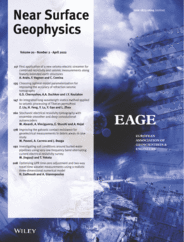-
oa Optimizing GPR time‐zero adjustment and two‐way travel time wavelet measurements using a realistic three‐dimensional numerical model
- Source: Near Surface Geophysics, Volume 20, Issue 2, Mar 2022, p. 208 - 226
-
- 22 Jul 2021
- 14 Dec 2021
- 19 Feb 2022
- Previous Article
- Table of Contents
- Next Article
Abstract
Time‐zero adjustment or the true ground surface for ground penetrating radar (GPR) applications is a very important aspect and an essential factor in order to position subsurface targets, especially those located at shallow depths, at their true position in depth. As the transmitted and received signals from GPR antennas are affected by the presence of different materials with varying electromagnetic properties, adjusting the time zero appropriately is important, but often not straightforward to position accurately. This paper uses a realistic three‐dimensional numerical model of a GPR transducer in order to examine where is the best location for time zero on a GPR trace. It is shown that, in order to establish a robust and consistent time‐zero position, careful consideration is also needed around how the two‐way travel time of the reflected GPR wavelet is estimated. Starting with a simple homogeneous model with a set of different targets, a better process of time‐zero adjustment and time picking of the GPR wavelets is put forward, that is verified using further more complex and realistic heterogeneous models. Further verification is obtained by using experimental data.




